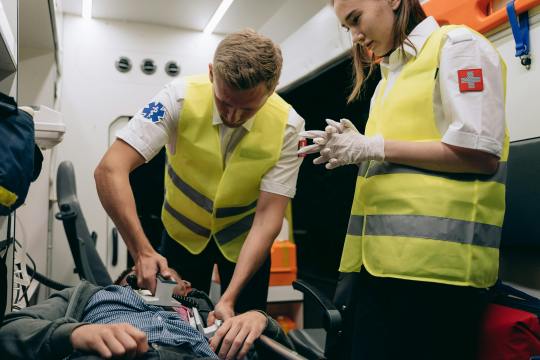#Kathie Greear
Explore tagged Tumblr posts
Text
Understanding Automated External Defibrillators

Heart problems are a major health concern. In the US, for example, approximately half a million individuals experience cardiac arrest every year; 60 to 80 percent die. However, the survival rate may increase two- or threefold with immediate action utilizing cardiopulmonary resuscitation (CPR) and automated external defibrillators or AEDs.
Simple to operate, the AED device uses clear verbal and visual cues to help rescuers without special knowledge safely implement defibrillation (shock delivery to restore normal heart rhythm). Some AEDs prompt the rescuer to assess the patient’s breathing and pulse first and, if there is no pulse, initiate chest compressions and summon emergency services immediately.
AEDs are either semi-automated or fully automated. Semi-automated AEDs necessitate user involvement during shock delivery, while fully automated ones execute the process independently. With semi-automated models, the user applies adhesive pads to the patient’s bare chest, and the device analyzes the cardiac rhythm, providing voice prompts if a shock is advisable to restore normal function. Upon delivering the shock, users immediately administer CPR until the device reanalyzes the rhythm as it counts down.
Designed to be used by lay responders, trained emergency personnel such as police, firefighters, and flight attendants frequently operate AEDs. Basic CPR and AED certification training, offered by organizations such as the American Heart Association or the Red Cross, can boost user confidence. Public-access AED programs help disseminate devices and first-aid education in local communities. However, AEDs are highly accurate in rhythm assessment and will only prompt shock delivery when medically warranted.
AEDs are not only deployed in first-responder vehicles such as ambulances and fire trucks but also strategically placed in high-traffic areas by health departments, local governments, and emergency response teams. These areas include sports arenas, airports, public transportation hubs, schools, and other venues. The widespread availability of AEDs in these settings offers significant benefits, such as increasing out-of-hospital cardiac arrest survival rates by up to 40 percent compared to scenarios where AEDs are unavailable. Every minute without defibrillation reduces the chance of survival by as much as 10 percent for those experiencing cardiac arrest.
To ensure quality and reliability in cardiac emergencies, the Food and Drug Administration (FDA) mandates that all AED manufacturers obtain premarket approval for their devices and accessories through rigorous testing and evaluation. The agency maintains and publishes lists of approved AEDs and accessories. Ongoing monitoring and product recalls (where necessary) help maintain confidence in the approved AEDs' intended functionality during critical incidents.
While proper AED use can be life-saving, minor transient side effects exist. Patients typically experience brief discomfort, akin to a bee sting or static-electricity zap, at the electrode placement sites. However, these sensations rarely result in long-term health issues. Patients may also experience brief fatigue and confusion immediately after treatment due to the physiological stress of cardiac arrest, which typically resolves rapidly.
Adhering to specific precautions is crucial to ensure safe AED operation. First responders should look for hazards, such as wet or damp conditions, that could cause unintended electrical conduction. Nearby metal objects or individuals in contact with the patient could result in unwanted shocks. Most importantly, users should precisely follow on-screen and voice prompts to ensure safe and effective AED use. Regular equipment maintenance, including timely replacement of electrode pads and battery per manufacturer guidelines, is equally vital to maintaining optimal device functionality.
0 notes
Text
The Basic Forms of Quilts

Quilts are a broad category of decorative hanging or blanket, spanning a diverse range of techniques, designs, applications, and fabric types. The most basic is the patchwork (or pieced) quilt, which involves the maker cutting and sewing together a variety of contrasting and complementary fabric pieces. Blocks are sewn together, pressed, and sewn into larger columns or rows, This sewing together is often done in a repetitive geometric pattern and can include hexagons, pinwheels, stripes, triangles, or eight-pointed stars.
Some traditional pieced quilts, such as crazy quilts and log cabins, employ “foundation piecing” techniques of stitching small pieces of fabric, not just into each other, but into a larger ground fabric. When creating mosaic-style patchworks, traditional British quiltmakers use a similar foundation paper-piecing (FPP) technique. This involves using paper as the foundation, which stabilizes the quilt block and allows for the placement of unusual, small, and detailed pieces. The paper is printed with a template, which lays out the shape of pieces and where they will be sewed to each other, or directly to the paper. Once the fabric is sewn and arranged, the paper is removed, yielding a finished quilt.
The applique quilt involves adding decorative fabric to the already made quilt, employing shapes that extend well beyond squares, triangles, and rectangles. The shapes can be cut from fabric in any design, including curves and abstract elements (as they are not sewn together, but to the underlying quilt, they do not need to match through straight lines).
There are a number of applique techniques, including the traditional needle turn hand sewing method of cutting shapes with a seam allowance, which is the area between stitch and fabric edge. The pieces are next pinned to the background in a preferred position. A sharp needle end is used to turn-under that seam allowance on each patch. The pieces can now be sewn in place using a blind stitch, with the pins then taken out. The sew and turn technique eliminates the requirement of turning under the seam allowance, prior to shapes being sewn into the background.
The raw edge or iron-on technique involves tracing the piece’s outline onto fusible web, or a thin sheet of sticky webbing. This is cut out, peeled off its backing paper and pressed onto the fabric’s reverse side, such that the shapes exactly match. When all the shapes are prepared, with the fusible web attached, they are simply ironed onto the background quilt, adhesive side down.
One essential when starting any applique project is to cut background fabrics that are larger than the target quilt size. This is because the background will often become distorted and shrink a bit as various shapes are added. Once all the pieces have been ironed on, the background can be squared.
Another technique involves making the embroidered quilt. This involves first creating a quilt with blocks that are relatively blank, which provides space for personalized stitching. The embroidery performed on this can be simple or complex, and may be used in simply outlining blocks and other shapes. It may also be used to add decorative elements such as small scattered stars, or X’s. It is also employed when adding commemorative elements to the quilt, as with a set of initials, a first name, a year, or a wedding date. Some quilt embroiderers stitch favorite phrases, while others add creative shapes, such as a set of family handprints.
0 notes
Text
Understanding Pulmonary Function Tests

Pulmonary function tests (PFTs) serve as noninvasive tools that offer insights into the function and health of the lungs. The tests encompass various key measurements that provide vital information about lung volume, capacity, airflow rates, and gas exchange. The results aid healthcare providers in diagnosing and formulating appropriate treatments for various respiratory disorders.
PFTs primarily address two types of disorders affecting air movement in and out of the lungs: obstructive and restrictive. Obstructive disorders involve difficulty with air flowing out due to airway resistance, resulting in decreased airflow. Examples of obstructive disorders include asthma and chronic obstructive pulmonary disease (COPD). Restrictive disorders, on the other hand, stem from limitations in lung tissue or chest muscle expansion, causing issues with airflow, particularly lower lung volumes. Interstitial lung disease and pneumoconiosis are restrictive disorders.
Medical professionals conduct PFTs through two main methods: spirometry and plethysmography. Spirometry employs a device with a mouthpiece connected to an electronic machine, while plethysmography involves sitting or standing inside an airtight box resembling a telephone booth.
The tests measure various parameters, including tidal volume (VT), minute volume (MV), vital capacity (VC), functional residual capacity (FRC), residual volume, total lung capacity, forced vital capacity (FVC), forced expiratory volume (FEV), forced expiratory flow (FEF), and peak expiratory flow rate (PEFR). The parameters indicate the lung’s health and ability to inhale and exhale air efficiently. Interpretation involves comparing individual test results with averages based on age, height, sex, and race.
PFTs serve diverse purposes, including routine health checks, occupational assessments in certain environments, and aiding in the diagnosis of respiratory issues such as allergies, infections, post-surgery complications, chronic lung conditions (asthma, bronchiectasis, emphysema), and diseases like asbestosis, sarcoidosis, and scleroderma. They are also valuable for assessing lung function before surgery, guiding treatment for chronic lung problems, and monitoring conditions like asthma and emphysema.
Preparation for PFTs involves understanding the procedure, signing a consent form, and informing healthcare providers about current medications. Professionals may ask patients to stop certain medications, refrain from smoking before the test, and avoid heavy meals or caffeine intake. Additionally, factors like patient cooperation, medication use, pain medicines, pregnancy, and overall health can impact the accuracy of PFT results.
The test involves the patient sitting in a chair with a nose clip, using a sterile mouthpiece connected to a spirometer. Professionals provide instructions for various breathing patterns, and the process may include the use of bronchodilators or substances that increase the diameter of the bronchi for specific tests. After the test, patients may resume medications and normal activities.
Professionals compare PFT results against normal ranges, and any abnormalities or changes from previous tests may prompt further investigations. Healthcare providers use the data to diagnose conditions, monitor progress, and formulate treatment plans. Patients usually receive results within a few days, with follow-up discussions scheduled to address any concerns.
While PFTs are generally safe, there are potential risks, including dizziness, shortness of breath, coughing, and, in rare cases, fainting or complications like a collapsed lung. Certain conditions or recent surgeries may contraindicate PFTs, emphasizing the importance of clear communication between patients and healthcare providers.
1 note
·
View note